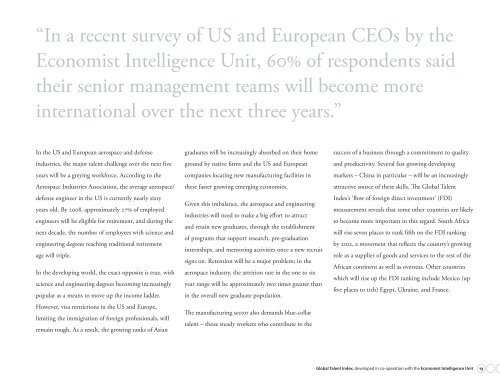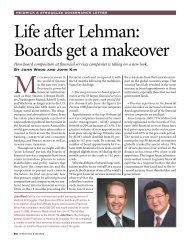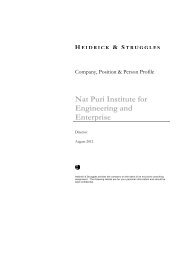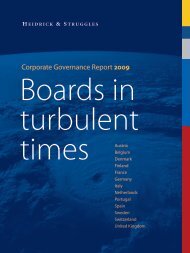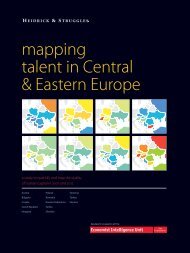Mapping Global Talent: Essays and Insights - Heidrick & Struggles
Mapping Global Talent: Essays and Insights - Heidrick & Struggles
Mapping Global Talent: Essays and Insights - Heidrick & Struggles
You also want an ePaper? Increase the reach of your titles
YUMPU automatically turns print PDFs into web optimized ePapers that Google loves.
“In a recent survey of US <strong>and</strong> European CEOs by the<br />
Economist Intelligence Unit, 60% of respondents said<br />
their senior management teams will become more<br />
international over the next three years.”<br />
In the US <strong>and</strong> European aerospace <strong>and</strong> defense<br />
industries, the major talent challenge over the next five<br />
years will be a greying workforce. According to the<br />
Aerospace Industries Association, the average aerospace/<br />
defense engineer in the US is currently nearly sixty<br />
years old. By 2008, approximately 27% of employed<br />
engineers will be eligible for retirement, <strong>and</strong> during the<br />
next decade, the number of employees with science <strong>and</strong><br />
engineering degrees reaching traditional retirement<br />
age will triple.<br />
In the developing world, the exact opposite is true, with<br />
science <strong>and</strong> engineering degrees becoming increasingly<br />
popular as a means to move up the income ladder.<br />
However, visa restrictions in the US <strong>and</strong> Europe,<br />
limiting the immigration of foreign professionals, will<br />
remain tough. As a result, the growing ranks of Asian<br />
graduates will be increasingly absorbed on their home<br />
ground by native firms <strong>and</strong> the US <strong>and</strong> European<br />
companies locating new manufacturing facilities in<br />
these faster growing emerging economies.<br />
Given this imbalance, the aerospace <strong>and</strong> engineering<br />
industries will need to make a big effort to attract<br />
<strong>and</strong> retain new graduates, through the establishment<br />
of programs that support research, pre-graduation<br />
internships, <strong>and</strong> mentoring activities once a new recruit<br />
signs on. Retention will be a major problem; in the<br />
aerospace industry, the attrition rate in the one to six<br />
year range will be approximately two times greater than<br />
in the overall new graduate population.<br />
The manufacturing sector also dem<strong>and</strong>s blue-collar<br />
talent – those steady workers who contribute to the<br />
success of a business through a commitment to quality<br />
<strong>and</strong> productivity. Several fast growing developing<br />
markets – China in particular – will be an increasingly<br />
attractive source of these skills. The <strong>Global</strong> <strong>Talent</strong><br />
Index’s ‘flow of foreign direct investment’ (FDI)<br />
measurement reveals that some other countries are likely<br />
to become more important in this regard. South Africa<br />
will rise seven places to rank fifth on the FDI ranking<br />
by 2012, a movement that reflects the country’s growing<br />
role as a supplier of goods <strong>and</strong> services to the rest of the<br />
African continent as well as overseas. Other countries<br />
which will rise up the FDI ranking include Mexico (up<br />
five places to 11th) Egypt, Ukraine, <strong>and</strong> France.<br />
<strong>Global</strong> <strong>Talent</strong> Index, developed in co-operation with the Economist Intelligence Unit 1


